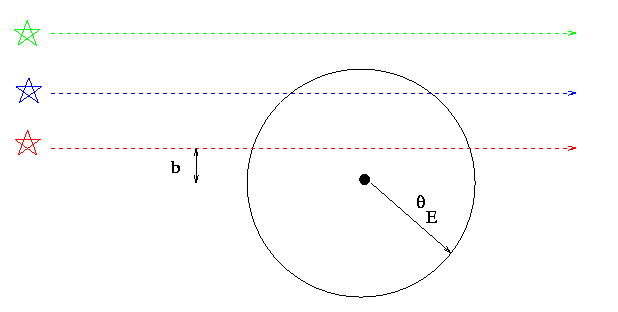
 Copyright © Michael Richmond.
This work is licensed under a Creative Commons License.
Copyright © Michael Richmond.
This work is licensed under a Creative Commons License.
As mentioned in the previous lecture, we are able to resolve the rings and arcs produced by very massive gravitational lenses: entire galaxies, and clusters of galaxies. The Einstein ring radius of a single star is tiny: about 0.001 arcseconds, much too small to be seen by telescopes on the ground or in space. So if one star were to pass directly in front of another, we would not notice a ring of light. Rats.
But -- gravitational lenses don't just distort light from the background object: they also magnify it. Even if the morphological change is too small to discern, we may see an increase in an object's brightness as it is lensed.
Now, if the increase in brightness occurred over a very short time, say, ten seconds, then we'd probably never notice. That's shorter than most astronomical exposure times, so we wouldn't see any gradual rise and fall. If the increase occurred over a very long time, say, fifty years, then we'd also probably not notice. That's just too long a period for a single scientist to keep watching the same star. But, if the change in brightness due to lensing occurs over just the right interval -- a few weeks to a few months -- then astronomers might indeed notice the variation from one night to the next.
This places some limits on the stars which act as lenses, and as background sources: they must be moving relative to each other at the right rate to cause the lensing geometry to change appreciably over a month or two. It turns out that if
The increase is very small unless the background source passes within the Einstein ring radius of the lensing object. In the example below, three background stars pass behind a lensing object, at different angular distances.

The red star has an impact parameter b which is much less than the lens' Einstein ring radius theta_E, so it will become much brighter as it moves past the lens. The blue star's impact parameter is larger, so it will brighten only slighty; and the green star's closest approach is beyond the Einstein ring, so it won't change much at all.
Technically, the amplification -- the factor by which a background star brightens -- is given by this equation:
Let u = b/theta_E
Then
u^2 + 2
max amplification = ----------------
u * sqrt[u^2 + 4]
Here's a table with some representative values:
u = b/theta_E max amplification
--------------------------------------------
5.0 1.00 no brighter
4.0 1.01
3.0 1.02
2.0 1.06
1.5 1.13
1.2 1.23 green star in figure
1.0 1.34
0.8 1.53 blue star in figure
0.5 2.18
0.2 5.07 red star in figure
0.1 10.04
As a star passes behind a lensing object, its light gradually becomes brighter and brighter. Its brightness peaks when the star is at its closest approach to the lensing object, then fades again as it moves away. The shape of this light curve is very distinctive:
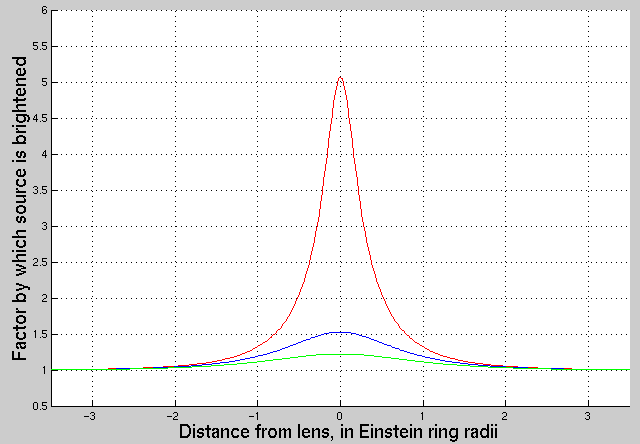
In order to distinguish a microlensing event from other variations in stellar brightness, astronomers rely on several criteria:
Okay, so it looks like it might be possible to recognize a microlensing event. But there's one problem left: how to find it! The chances that one star passes (nearly) directly in front of another are very, very small, because stars are very, very far away from each other, so that the ratio
apparent angular size of Einstein ring
---------------------------------------
apparent angular distance between stars
is very small.
If the size of a typical star's Einstein ring were comparable to the apparent angular distances between it and other stars, like this, then lensing events would happen frequently:

But in real life, the Einstein rings are much smaller than the apparent angular distances between them:

That means that lensing events between two stars occur VERY infrequently.
So, how to find very rare microlensing events? Look in places with lots of stars so that there are plenty of background sources. One good place is near the bulge of our Milky Way:
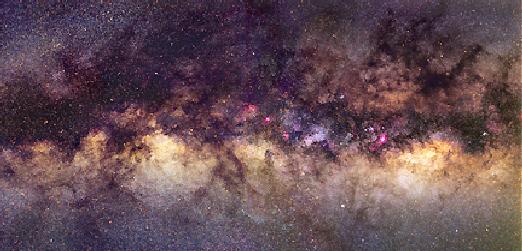
Another is in the Large Magellanic Cloud:
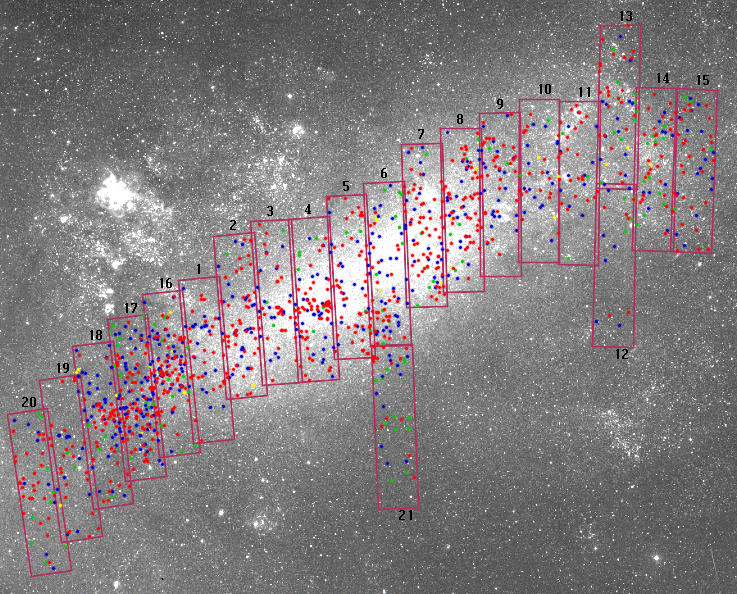
The MACHO project runs out of Australia. It adopted an old, broken-down telescope (which was once one of the largest in the world) and put it back into shape:
MACHO built a very sophisticated instrument package, which split light into red and blue beams and sent each into a different camera. Each camera has 4 CCDs on its focal plane, and can detect LOTS of stars.
The OGLE project is based in Chile. It uses a telescope with a mirror 51 inches in diameter, and a custom-built CCD camera.
The OGLE telescope spends most of its time looking at the bulge of the Milky Way, but occasionally points at the LMC. The pictures it takes are really crowded with stars:The OGLE group maintains an "Early Warning System," which allows astronomers elsewhere to see if any lensing events are currently occuring.
All three groups -- MACHO, OGLE, and EROS -- have detected stars which vary exactly as gravitational lensing theory predicts. Remember, if one star passes in front of another, theory predicts that the background source should become brighter like this:
Here, for comparison, is a gallery of variable stars identified by the OGLE group; clicking on the image will take you to their Interactive Lensing Database, which will give you more information on each event.
The goal of the microlensing searches was to discover lensing events. Each project acquired thousands of images of millions of stars, over periods of several years. The groups were looking for a very particular type of variation -- that predicted by gravitational lensing theory. However, they found thousands of stars which varied in other ways: plain old variable stars, which actually do change in brightness intrinsically (due to changes in size or temperature).
From the point of view of microlensing, these "ordinary" variable stars were annoying; but from the point of view of many astronomers, who study the behavior of stars, they were great!
| Before | After |
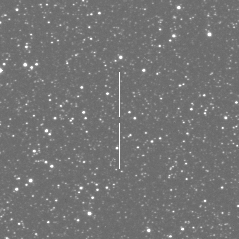 |
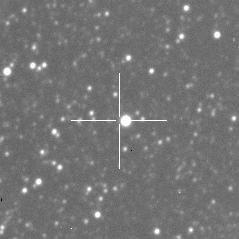 |
Further information:
 Copyright © Michael Richmond.
This work is licensed under a Creative Commons License.
Copyright © Michael Richmond.
This work is licensed under a Creative Commons License.